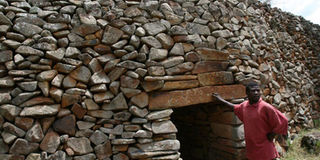Why ancient fortress still stands strong, centuries on

Joel Nyapala at Thimlich Ohinga ruins in Migori County. FILE PHOTO | NATION MEDIA GROUP
What you need to know:
- Situated about an hour’s journey by road from Migori town, and westwards towards the shores of Lake Victoria, this historical site has almost a striking resemblance to the ruins of the Great Zimbabwe in southern Africa.
- Locals argued that while the Portuguese had Jesus Christ as their protector, they had Thim Lich Ohinga, loosely translated in Dholuo as “frightening dense forest”.
- Thim Lich Ohinga has always been a subject of different researches, none of which has come up with the exact explanation of how the ancient man, always rebuffed for his perceived backwardness, could have come up with such an imposing structure.
It takes more than one hour to drive from Migori Town to Thim Lich Ohinga in the floods and drought- prone Nyatike sub-county in Migori County.
Perhaps this explains why both local and foreign tourists shy away from this important site, whose history dates back to the 15th century.
Little has changed since the National Museums of Kenya (NMK) took over its operations in 1980s.
It is actively marketed in the NMK website but visits to this place have been rare, mainly due to the region’s poor infrastructure.
Locals argued that while the Portuguese had Jesus Christ as their protector, they had Thim Lich Ohinga, loosely translated in Dholuo as “frightening dense forest”.
Made up of stone walls rising to about four and a half meters at the highest points, this structure not only epitomes architecture in the old days, but also manifests a near perfect combination of beauty, strength and balance.
The walls are built of loose stones and blocks without any dressing or mortar to hold them in place.
Situated about an hour’s journey by road from Migori town, and westwards towards the shores of Lake Victoria, this historical site has almost a striking resemblance to the ruins of the Great Zimbabwe in southern Africa.
Thim Lich Ohinga has always been a subject of different researches, none of which has come up with the exact explanation of how the ancient man, always rebuffed for his perceived backwardness, could have come up with such an imposing structure.
According to scanty records available, the ancients were using it as a fortress in the event of an attack by their enemies. They would sit here to plan how to launch an attack on their aggressors. But when they are subdued, they would retreat into the safety of the structure.
To gain entry, one has to bend almost to his knees.
“The entrance was made this way intentionally,” says Mr Silas Nyagweth, an NMK employee who is the officer- in-charge at the site.
He continued: “It was made that low to ensure that by the time the enemy got inside, he would be bending and therefore less stable. The guards could then easily overpower him”.
Inside, the fortress is divided into sections such as the cow pens, where the humans dwelt and where they did other chores and even engaged in recreational activities.





